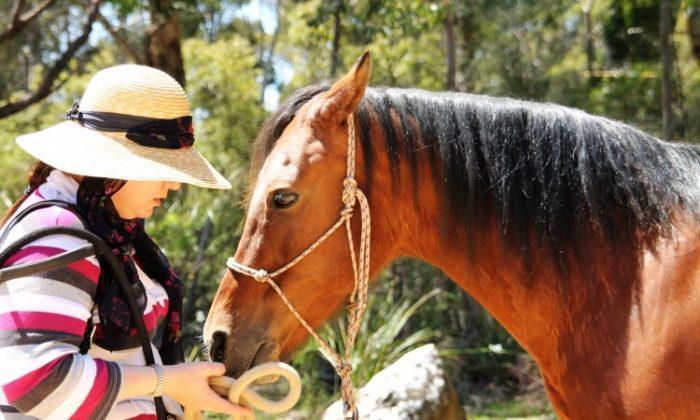When talking psychotherapy or emotional counselling most people conjure up images of reclining on a studded leather couch talking with a psychologist. But therapy need not always take this form, which to some can be uncomfortable and confronting. Traditional “talk-based” forms of counselling are effective, but there is another alternative method becoming more widely accepted, which is also an evidence-based approach: Equine Assisted Therapy (EAT).
The Presence of Animals
Incorporating animals in the process of self-discovery and emotional healing may seem very left-field compared to conventional approaches, but there has been much evidence that suggests that an animal-led approach is successful in psycho-intervention.
We are all familiar with the concept of using domesticated animals in hospitals and hospices to brighten a patient’s day. It is also well accepted that patting an animal can reduce blood pressure and help to lower a patient’s guard; a dog or cat can help patients feel at ease during treatment and consultation with a doctor.
Therapy involving horses was first used in Europe in the 1800s. Since then horses have played a role in helping people to overcome a wide variety of personal problems like depression, anxiety, eating disorders, sleep disorders and post-traumatic stress disorder—common among war veterans. Equine Therapy is also being used to treat children with autism or behavioural problems and children with a history of abuse.
Michelle Rookley, an Equine facilitator therapist and employee of Chiron Programs in Tasmania’s Huon Valley says that the horse-assisted sessions are relaxed and informal.
“From observations, I feel people are drawn to this therapy because it is not clinical. The sessions are in a natural setting, it is not a pressured environment. The focus is not on the person as a ‘patient’,” she said.
Ms Rookley also has experience working as a nutritionist and she incorporates this knowledge into her horse-led therapy sessions to assist people affected by eating disorders.
Ms Rookley says that after spending time with the horses people often comment that they are feeling more positive, more empowered and more confident.
“We believe that horses have a power which is uniquely transformative. They can teach us compassion, respect, humility, patience and gratitude,” she said.
The Horses’ Place in the Arena of Healing
EAT is not horse riding. It is a personalised therapy session conducted by a trained horse specialist, a licensed health counselor, and a small herd of horses—specially trained to be calm and docile.
Different countries have set up different models for conducting EAT, and so there are slight differences in the way a session is conducted.
Australia, a typical session may be conducted as follows: the patient will be guided to undertaking groundwork with the horses such as leading them along an obstacle course or brushing them.
When the session with the horses finishes the participant is invited to verbalise arising thoughts and feelings. The Equine Assisted Therapy Facilitator brings attention to the themes being raised. Through discussion and self-reflection the patient may become aware of negative notions or thought-patterns, which may lead to a holistic change.
“Why horses?” you may be asking. Horses are highly responsive animals, which naturally “group” together, and are therefore sensitive to the feelings and body language of their herd. When around humans they are expert body language readers and can pick up on intentions and attitudes in a non-judgmental way. Through observing interactions between the participants and the horses, the therapist can gain insight into behaviour patterns and mental obstacles that the participant may not be aware of.
Ms Rookley has witnessed this curious experience firsthand. “Quite often the horses are reflecting a person’s inner issues and mental-emotional health, though sometimes not in obvious ways. In a group scenario people often connect to horses which reflect their personality—providing insight,” she said.
Everyone Can Benefit
EAT is not just for people in need of psychotherapy. This approach is also being used by people in the corporate sector to build on life skills such as leadership, self-confidence, motivation and being more open and sensitive to their peers.
Equine Assisted Learning (EAL) is another approach within the same field of philosophy. In this approach, through close contact with horses, children and adolescence learn about themselves and the importance of positive, socially acceptable behaviour. This therapy has proven to be useful with children with Attention Deficit Disorder (ADD), aggression and anti-social behaviour.
Ms Rookley has assisted a large variety of people in her community through EAT. She has helped children who are not coping with peer situations, people who are experiencing grief and others who are suffering from eating disorders, to name a few.
During an EAT session a participant is placed in the role of being a leader and clear communicator to guide the horse—without being domineering or spooking it. Through this learning, Ms Rookley believes that EAT can play a positive role in resetting healthy personal boundaries when re-building family relationships.
“EAT can be beneficial for families who are seeking to re-story their patterns of interaction. This therapy is a part of rediscovering self and others and the world that we live, in a healthy way,” she said.
Anyone can try Equine Assisted Therapy or Learning as no previous experience or horse-handling skills are required. People of all ages and fitness levels are welcome to take part; all you need is a willingness to connect with horses and an open mind.





Friends Read Free